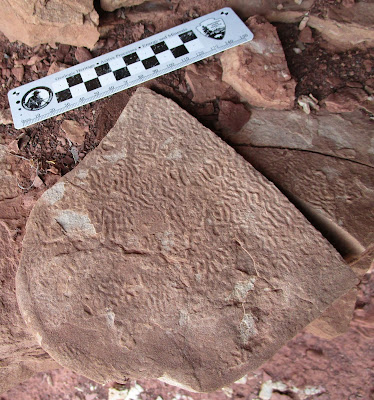Here we have a textbook example of Rugalichnus. This particular example was observed in the Wupatki Member of the Moenkopi Formation at Wupatki National Monument.
 |
| Click to embiggen; it's the labyrinthine surficial feature. |
That's all well and good, but what is Rugalichnus?
First off, it's not Rivularites. (For some reason Rivularites has attached itself to my mental conception of features like this, but that's not important.)
Rugalichnus is a microbially induced sedimentary structure (MISS), which is a reasonably self-explanatory name: it's a sedimentary structure that resulted from the influence of a microbial mat. This means it has a metaphorical foot both in "trace fossil" and in "sedimentary structure". Another way of thinking about it is as a cousin to stromatolites. It isn't stacked and occurs in clastic rocks rather than carbonates, but it shares the same principle of a sticky microbial mat influencing the preservation of sedimentary features.
Features similar to Rugalichnus have been reported for more than a century. Charles Doolittle Walcott (1914) named the ur-example Kinneyia simulans from Precambrian rocks in Montana, thinking it was an algal fossil. It became a topic of controversy for decades, culminating in the "genus" and "species" turning out to be an inorganic dud (Davies et al. 2016; Stimson et al. 2017). If you look at the figure below, you might think you're seeing a bedding plane, like the object in my photo. However, it isn't; it's actually an artifact of weathering. Stimson et al. (2017) opted to coin the new name Rugalichnus matthewi for the MISS features that people had been calling "Kinneyia" (and yes, the naming of MISS is a can of worms unto itself).

|
|
Kinneyia simulans. Plate II, Figure 3 in Walcott (1914). |
There are many varieties of MISS, reflecting the many ways a microbial mat can interact with its sedimentary substrate. Rugalichnus is known from storm wave deposits, indicating it formed after storms (Herminghaus et al. 2016). When Rugalichnus (as Kinneyia) was first interpreted as a MISS, it was thought to have formed beneath an active microbial mat (see for example Porada et al. 2008 and Thomas et al. 2013). Mariotti et al. (2014) proposed instead that the ridges and troughs resulted from rolling mat fragments and loose mat ends. Herminghaus et al. (2016) conceded that there were circumstances that could produce the wrinkle structures using the Mariotti et al. model, but preferred their own hydrodynamic instability model from Thomas et al. (2013). Given that there are abiotic features that look very similar (Davies et al. 2016), there's certainly no reason to assume that all Rugalichnus-like wrinkles formed the same way. Me, I don't have a horse in this race; I just find the structure interesting.
References
Davies, N. S., A. G. Liu, M. R. Gibling, and R. F. Miller. 2016. Resolving MISS conceptions and misconceptions: A geological approach to sedimentary surface textures by microbial and abiotic processes. Earth-Science Reviews 150:210–246.
Herminghaus, S., K. R. Thomas, S. Aliaskarisohi, H. Porada, and L. Goehring. 2016. Kinneyia: a flow-induced anisotropic fossil pattern from ancient microbial mats. Frontiers in Materials 3. doi:https://doi.org/10.3389/fmats.2016.00030.
Mariotti, G., S. B. Pruss, J. T. Perron, and T. Bosak. 2014. Microbial shaping of sedimentary wrinkle structures. Nature Geoscience 7:736–740.
Porada, H., J. Ghergut, and E. H. Bouougri. 2008. Kinneyia-type wrinkle structures—critical review and model of formation. PALAIOS 23:65–77.
Stimson, M. R., R. F. Miller, R. A. MacRae, and S. J. Hinds. 2017. An ichnotaxonomic approach to microbially induced sedimentary structures from the Saint John Group of New Brunswick: why comparison to Kinneyia Walcott 1914 must be abandoned. Ichnos 24(4):291–316. doi:10.1080/10420940.2017.1294590.
Thomas, K., S. Herminghaus, H. Porada, and L. Goehring. 2013. Formation of Kinneyia via shear-induced instabilities in microbial mats. Philosophical Transactions of the Royal Society A 371(2004):20120362.
Walcott, C. D. 1914. Cambrian geology and paleontology III, no. 2. Pre-Precambrian Algonkian algal flora. Smithsonian Miscellaneous Collections 64:77–156.
No comments:
Post a Comment